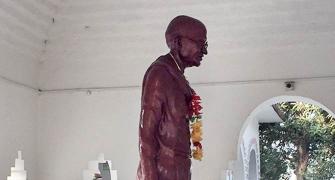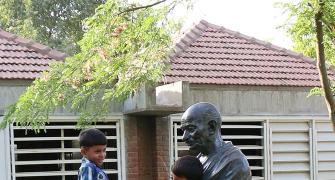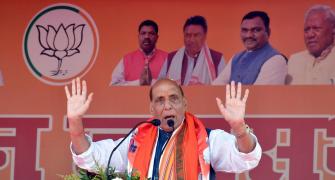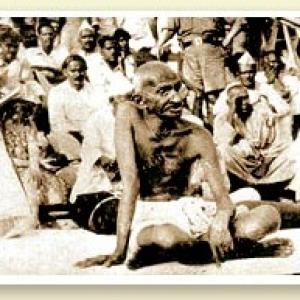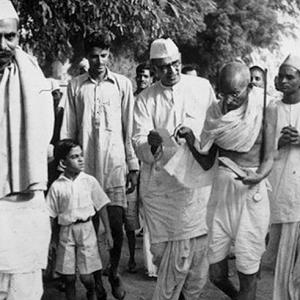The fight for freedom was long and hard and that is why it is important to go back to the monuments that celebrate those who fought the good fight.

'Do or Die'.
'It is only when individuals go out to die that the nation will survive', said Gandhi.
With three short words: 'Karenge Ya Marenge', ordinary Indians came together, risking their all for freedom.
Rediff.com's Archana Masih and Rajesh Karkera go back to where Gandhiji was imprisoned for two years during the Quit India Movement which began that momentous August 81 years ago.
It was a hot sunny day, the parking lot was vacant and the ticket window closed. A notice pasted outside said paper tickets were no longer sold and visitors had to scan the QR code and pay for the tickets online.
Once that was done, the staff at the impressive gate that led to an even more impressive driveway, checked the phone screen and waved us in.
Entering the Aga Khan Palace in Pune is a pilgrimage into an important chapter of our freedom struggle. The story that unfolded inside the palace -- donated to the nation by the Aga Khan -- began today, August 9, exactly 81 years ago.

As we walk in looking at the elegant mansion built in 1892 by the third Aga Khan, the spiritual head of the Khoja Ismaili community, I look at the pathway where Gandhiji once walked.
Flanked by British officials, he must have walked up these stairs as he began two years of imprisonment during the Quit India Movement -- a short, sharp and brilliant slogan given by Yusuf Meherally, one that post-Independence copywriters must have doffed many a hat to.
The Mahatma, the heart and moral compass of India's unique freedom movement, was 73 at that time. The canopy of trees on the ground must have provided shade and succour to him, his devoted wife Kasturba, secretaries Mahadev Desai and Pyarelal Nayyar, the latter's sister Dr Sushila Nayyar, who was Gandhi's physician, Sarojini Naidu and Mirabehn, the British admiral's daughter who became a life-long Gandhian, and Prabhavati Narayan, Jayaprakash Narayan's wife.

Ba and Mahadev Desai breathed their last in the respective rooms they were incarcerated in. They died as prisoners and did not live to see a Free India.
Except mobile phone cameras, other cameras are not allowed inside the campus without special permission -- and that can only be sought from Mumbai, nearly 100 kms away. The staff has a sound reason for that complex permission granting procedure.
"People used to shoot pre and post wedding photographs and videos here. They used the washrooms to change, apply makeup and left it dirty. The grounds were also trampled upon," says a member of the staff.

The shady grounds are well kept; a few families sit under the shade. Behind the mansion are the samadhis of Ba and Mahadev Desai, Gandhiji's personal secretary for 25 years who died just a week after being imprisoned on August 15, exactly five years short of the dawn of Independence.
Both Ba and Mahadevbhai rarely left Gandhiji's side and were cremated on the grounds. Their marble samadhis are small and simple structures with Tulsi plants.
The third samadhi contains a part of the Mahatma's ashes.
The resting places stand out because of their simplicity. There are benches under a shady roof where you can sit and look at the samadhis surrounded by trees. There is a peace in the quietness -- even the video playing on the phone of the security guard does not seem too disturbing.

Mahadev Desai was just 50 when he died. In 50 years, he did 100 years' worth of work, Gandhiji said of him. According to anthropologist Verrier Elwin who also worked with Gandhiji, Desai was much more than Gandhi's secretary.
'He was in fact Home and Foreign Secretary combined. Mahadev's task was to make Gandhi real to millions. He made him perhaps the best known man in the world, certainly the best loved,' Elwin wrote in an essay as mentioned in a column by Gandhi historian Ramchandra Guha, who, incidentally, is also the biographer of Elwin.
Mahadev Desai was a diligent chronicler; he wrote a diary every day which was a repository of the most authentic insights into Gandhi's life, philosophy, peculiarities etc.
His last entry was on the day before he died.

The large airy rooms of the Aga Khan Palace open into a verandah that runs along the sides of the stately mansion which was constructed to provide employment to villagers during a famine in the 1890s. It was declared a national monument in 2003.
The large doors have boards outside indicating the importance of what once lay inside. These are rooms were Gandhiji and Ba lived and where she breathed her last.
'She considered it her duty to lose herself in me. She did not cease to look after me till her last breath,' reads a quote by Gandhi on the walls of the museum about his wife of 61 years.

There are articles used by them inside the room -- chair, charkha, walking stick, wooden slippers, metal glass and bowl, the seating on the ground draped in khadi -- all glorious in their simplicity.
The room is out of bounds and one has to peer from behind a wall of glass which comes as a disappointment. One would have liked a closer look.
In one of the rooms lived Sarojini Naidu, a prisoner for seven months who was released due to ill health. Mirabehn, who was Gandhi's disciple, also occupied a corner in the palace.

Born Madeline Slade and a great lover of Beethoven's music, Mirabehn lived in India for nearly 35 years, playing an important role in India's Independence struggle.
She moved to the outskirts of Vienna in 1960 and lived in the environs that had inspired Beethoven, listening to his music and writing about it.
Diplomat K L Dalal, who served in as India's ambassador to Austria in the early 1980s, recalled that one of the tasks entrusted to him by then prime minister Indira Gandhi was to ensure that Mirabehn was looked after.
In 1981 she was awarded the Padma Bhushan which was presented to her in the cottage by Ambassador Dalal by a country that will always be indebted to her.

There were others imprisoned in the Aga Khan Palace during the Quit India movement that many may not know of, which highlights the fact that Indians from all walks of life together dreamt the dream of freedom and fought hard to make it into a reality.
One of them was Dr M D D Gilder, a Bombay cardiologist who studied medicine in the UK and had the double distinction of passing the MD and FRCS examinations in the same year.
Dr Gilder had served prison time with Gandhiji in Yerwada prison and was released from the Aga Khan Palace at the same time as Gandhiji.
He was a member of the Rajya Sabha post-Independence and is known to be the first cardiologist to own a cardiograph in India in 1912, according to the Web site Plarr's Lives of the Fellows, the Royal College of Surgeons of England.

The large black and white photographs, pictorial and audio displays at this national monument are engaging. The information well displayed, well-produced and is a refresher course of the time when 'Do or Die' and 'Quit India' slogans rent the air.
It however does not provide insights into the daily life of those interned here, which would have been interesting to know.
A walk through the rooms tells you how the underground radio was run by Gandhians at great risk to their lives, helmed by stalwarts like Usha Mehta and the sacrifice of seven students who were shot dead as they attempted to hoist the Tricolour on top of the Patna secretariat.

After the Congress gave the call for the British to Quit India, its leaders were arrested. Jayaprakash Narayan and Ram Manohar Lohia went underground and played an important role in the movement.
The press was muzzled, communication disrupted and the information on the Aga Khan museum walls tells you that rumour had spread that the British had taken Gandhi to Africa.
Other leaders -- Jawaharlal Nehru, Vallabhbhai Patel, Abul Kalam Azad were imprisoned in the Ahmednagar fort for nearly three years.

The mass movement raged on. More than 150 police stations were attacked, trains ran late or did not run at all. 900 civilians were killed between August and November 1942, 60,000 arrested, 538 whipping punishments were meted out.

The Bharat Chhodo Andolan was the final push and a turning point in India's extraordinary struggle for Independence that was rooted in non violent civil disobedience.
The fight for freedom was long and hard and that is why it is important to go back to the monuments that celebrate those who fought the good fight.
Feature Presentation: Aslam Hunani/Rediff.com

